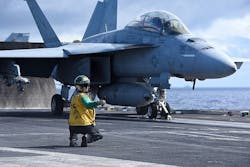Boeing to upgrade electro-optical infrared search and track (IRST) systems for Navy jet fighter aircraft
Officials of the Naval Air Systems Command at Patuxent River Naval Air Station, Md., announced a maximum $131.6 million order Thursday to the Boeing Co. Defense, Space & Security segment in St. Louis to build and upgrade weapon-replaceable assemblies to optimize the Block I low-rate initial production F/A-18E/F IRST.
The order includes technical risk reduction related to an engineering change proposal, and asks Boeing experts to provide integration and tactics development.
The Super Hornet's IRST is a long-wave infrared detection system that can detect and lock weapons onto enemy aircraft without using radar. The system detects hot spots on aircraft -- particularly their engine exhaust. The passive system does not emit RF energy like radar does, and can help conceal the presence of its aircraft.
The system for jet fighters, which Boeing is buying from the Lockheed Martin Missiles and Fire Control segment in Orlando, Fla., uses infrared search and track technology to detect and provide weapon-quality track solutions on potentially hostile aircraft.
The electro-optical IRST Block I, also called the IRST21 Sensor System, fits on the front of the Super Hornet's centerline fuel tank. Two years ago Navy leaders approved a restructured program that foregoes full-rate production of Block I sensors and proceeds directly to the Block II system.
The IRST consists of a passive longwave infrared receiver, a processor, inertial measurement unit, and environmental control unit. The infrared receiver, processor, and inertial measurement unit fit inside the sensor, which attaches to the front of the fuel tank mounted on the Super Hornet's BRU-32 bomb rack.
The Navy developed the IRST Block I using components from the F-15K/SG aircraft's infrared receiver, which is based on the IRST design of the now-retired Navy F-14 Tomcat jet fighter. IRST Block II will include improvements to the infrared receiver and updated processors.
At this stage, existing IRST Block I systems will support testing and tactics development. Navy leaders say they will begin the Block II operational tests in 2020. The Navy intends to produce 170 IRST systems.
Even amid electronic attack or heavy RF and infrared countermeasures, IRST provides autonomous, tracking data that increases pilot reaction time, and enhances survivability by enabling first-look, first-shoot capability, Lockheed Martin officials say.
The IRST's stealth characteristics can enable Super Hornet pilots to make positive identification of enemy aircraft at long ranges, and enable them to fire their air-to-air missiles at maximum ranges.
Data from the IRST system can stand alone or fuse with other on-board sensor data situational awareness. Lockheed Martin also is developing an IRST pod for the F-15C and F-16 jet fighters.
On this order Boeing and Lockheed Martin will do the work in Orlando, Fla., and in St. Louis, and should be finished by April 2022. For more information contact Boeing Defense, Space & Security online at www.boeing.com/defense, Naval Air Systems Command at www.navair.navy.mil.
Ready to make a purchase? Search the Military & Aerospace Electronics Buyer's Guide for companies, new products, press releases, and videos
